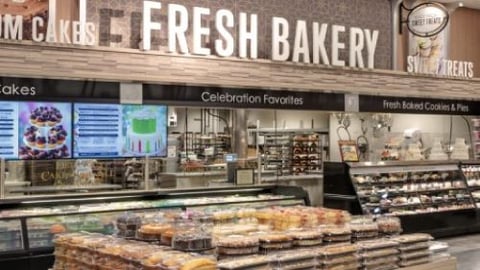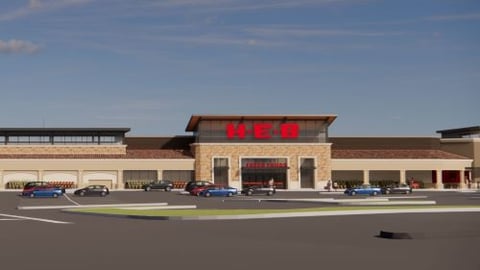How to Renovate Stores on a Budget
Appearances count, particularly in grocery, whose brick-and-mortar environment should look just as fresh as the meat, milk and produce it offers. But keeping up appearances has become tougher. The cost of labor and materials has increased dramatically, while COVID-19-related work stoppages at the height of the pandemic have decreased today’s availability of equipment and supplies.
Released in December 2022, the Construction Cost Index, from global real estate services company CBRE, forecasted a 14.1% increase in construction costs (labor and materials) by year-end 2022. To cut costs and keep renovations on schedule, retailers are performing less costly, smaller-scale facelifts. They’re also using more domestic suppliers, purchasing used equipment, sprucing up existing equipment and scaling down decor. Amid these money-saving moves, however, they’re continuing to invest in areas that are key customer touchpoints or drive new revenue, such as restrooms, self-checkout and online order pickup areas.
“We may not be touching every element we did before,” affirms Veronica Jimenez, VP of construction and maintenance at Ontario, Calif.-based Hispanic grocer Cardenas Markets. “We may be paring down to some small decorative elements, whereas we might have gone over the top in the past. Do we need a real brick façade, or can it be faux brick? A fresh coat of paint can work wonders in lieu of significant structural modifications. It’s the ‘value engineering’ flavor of the day. We’re putting function and form over vibrence.” Jimenez adds that building materials’ prices have increased 100% compared with pre-COVID levels.
While costs have mushroomed, budgets have not necessarily done so. “We must pivot,” notes Jimenez. “What’s the ‘look’ for less? How do we get the overall feel authentically or equipment-wise?” Cardenas renovates 10 locations annually, using its store-wide Clean & Bright model, and makes smaller changes to an additional 40 to 50 locations.
According to Rick Weinberg, EVP at Los Angeles-based CBRE, grocery stores are typically “refreshed” every four or five years and remodeled every seven to eight.
Grocers’ post-COVID demand for remodeling has increased, with the pandemic and inflation driving grocery sales. New store growth, however, has slowed since retailers can’t maintain opening schedules. “The grocery industry is flourishing,” says Blake Sloan, partner and director of business development at architecture and design firm Heights Venture, in Plano, Texas. “Prices for remodels went up and the remodel list grew. But with new stores, every day you don’t open, you’re losing money.”
Factories that closed during the pandemic have reopened, but many are behind schedule and understaffed, notes Sloan, adding that supply chain snarls “slowed down our schedules 25% to 50%.”
Freezers and Refrigeration
A category hard hit by price increases and product availability is equipment, namely freezers, refrigeration units, stoves and ovens. According to Eric Truskowski, director of retail project management at CBRE, refrigeration equipment prices in particular have soared. “Fixture and display costs have increased some, but refrigeration equipment has outpaced fixturing,” says Truskowski. “Chip availability for refrigeration and HVAC controls is also a large factor.”
[Read more: "New Ways to Approach Cooling in Stores"]
Costs often increase post-order. “Lead times are killing us,” notes Jimenez. “Six months down the line, you’ll get a notice saying cases went up in price. They’ll say, ‘Want it or not? We’ll give it to someone else.’ It’s hard to get units in a timely manner.”
Steve Duffy, SVP of design at Orlando, Fla.-based architecture firm Cuhachi Peterson, has seen the timeline for hardlines orders “virtually double” for a Midwestern grocery client that ordered from a major manufacturer. “We’re trying to lock in designs on a store where the equipment won’t show up until a year from now,” says Duffy. “We’re looking at existing equipment to decide if they can keep it rather than wait.” Service technicians are also in short supply, he points out.
Retailers have turned to domestic suppliers and those in nearby countries to reduce lead times, but that’s also challenging. Used and refurbished equipment is another option. “There’s a limited number of U.S. manufacturers that make refrigerated cases for grocery stores,” says Sloan. “The refurbished market has gotten big.”
While used equipment can be a viable option, Duffy notes that some will soon be obsolete, since old technologies are being “phased out.” He adds that such equipment “must comply with Department of Energy requirements.”
Less Fancy Artwork
One area where grocers are cutting back significantly is décor. Special artwork like department murals, for example, is being replaced by more modular art or signage that’s easier to ship from local suppliers and can be replicated across multiple locations, according to Sloan. “They’re looking at more economical ways to do department décor and wayfinding,” he says. “You can spend less and people will still know where the pharmacy or seafood department is.”
Sloan has also had clients that believe expensive murals and 3D sculptures make customers think a store’s food is expensive. “There’s some psychology involved,” he observes. “A cleaner look may make shoppers think groceries cost less.”
Artificial materials can also come into play. Duffy points to a customer that used a printed brick pattern in multiple areas rather than real or faux brick.
On the Shelf
Like other elements, store fixtures and other display units have become less fancy. There is also less use of custom fixtures and ones specific to one store or department. Existing fixtures can often be refurbished for another use.
“How can we extend their lifecycle?” muses Billy Plummer, principal at Baltimore-based architecture firm CallisonRTKL. “Can we sand it, re-stain it, wax it, versus putting in new ones? There are more discerning audits of what still has life to live. They may use them in another store.”
Supermarkets are also using more branded fixtures provided by merchandise suppliers. These offer a distinctive look and merchandise products a particular way. Additionally, according to Plummer, they’re faster and cheaper to procure.
Retailers that want to replace floors and ceilings are also cutting costs. Instead of buying new ceiling tiles, Sloan notes that grocers simply apply paint. With floors, retailers often want to remove tiles and resurface the concrete, but laying vinyl tiles is cheaper and less disruptive. This is particularly true in older stores, where existing tile glue may contain asbestos and “brings up abatement issues,” he adds.
No Last-Minute Changes
Exorbitant costs and lead times have pretty much put the lid on making last-minute changes to renovation plans, something the grocery industry is famous for. “You don’t have that luxury,” asserts Duffy. “That’s untenable today, unless you’re just moving a case’s location. It’s hard to upgrade at the last minute.”
Last-minute changes — and pitfalls — can often be avoided through use of BIM (building information modeling) software. The 3D digital tool, in short, virtualizes a project from concept to completion and on through its whole lifecycle. In recent years, increasing numbers of retailers have begun using BIM.
The software lets layers of projects be turned on and off. This facilitates activities like moving refrigeration equipment from one store to another. “With 3D, you discover things ahead of time, rather than when you’re doing surveys,” adds Plummer. “It’s easier to plan something like moving duct work. And if you move a beam to raise a portion of the store, you don’t have to worry about hitting something you didn’t plan for.”
Three-D also allows architects and designers to better communicate with retail executives about projected outcomes. According to Sloan. “[These] models are ‘smart’ enough that we can show them how something will look. It helps them make better decisions.”
At press time, the costs of raw materials like steel and lumber were declining. CBRE predicts that construction cost escalation should stabilize to the 2%-to-4% range this year and the next, on par with historical averages. Long lead times and materials shortages will likely continue in the short term, however.
“Money isn’t going as far as it did a few years ago,” says Duffy, “but grocers are seeing a bit of easing up on cost and availability of materials.”







